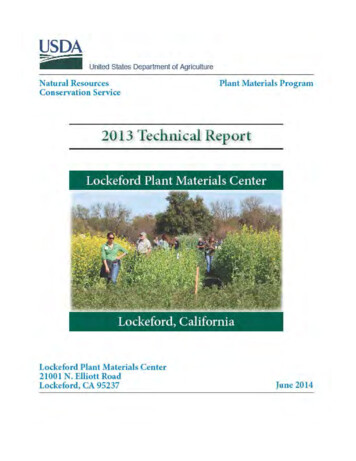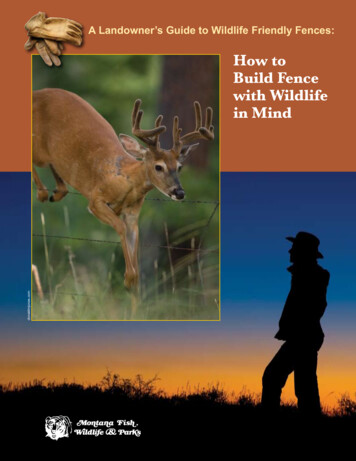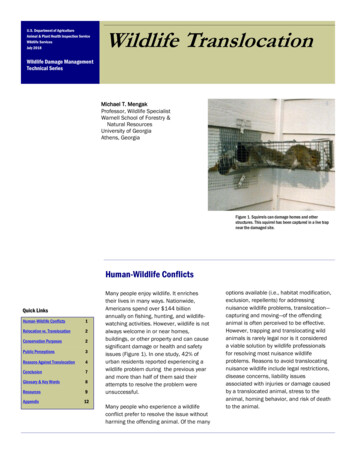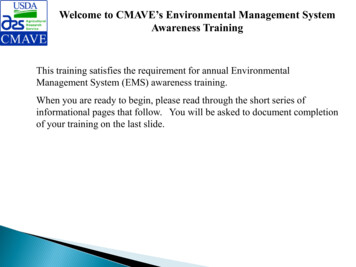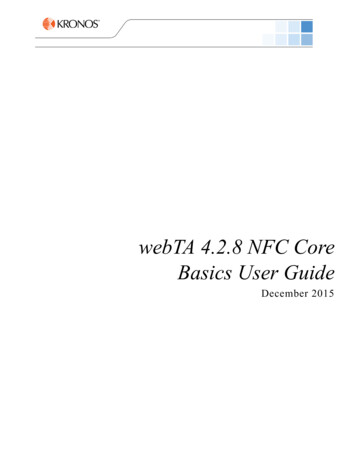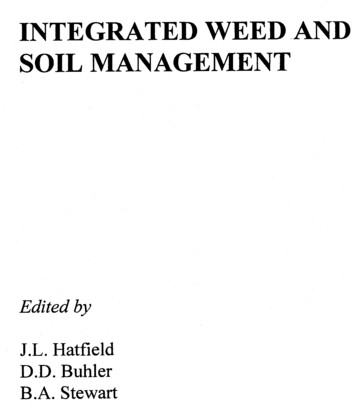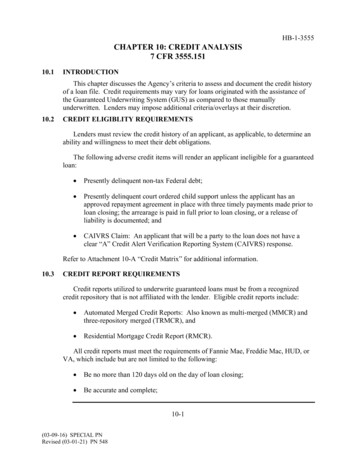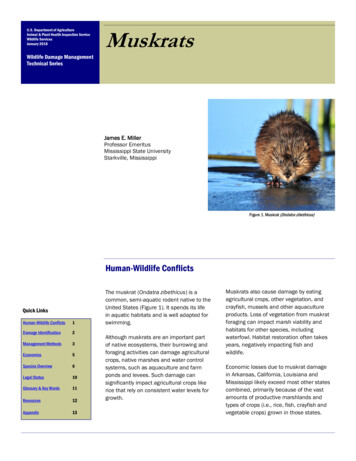
Transcription
U.S. Department of AgricultureAnimal & Plant Health Inspection ServiceWildlife ServicesJanuary 2018MuskratsWildlife Damage ManagementTechnical SeriesJames E. MillerProfessor EmeritusMississippi State UniversityStarkville, MississippiFigure 1. Muskrat (Ondatra zibethicus)Human-Wildlife ConflictsQuick LinksHuman-Wildlife Conflicts1Damage Identification2Management Methods3Economics5Species Overview6Legal Status10Glossary & Key Words11Resources12Appendix13The muskrat (Ondatra zibethicus) is acommon, semi-aquatic rodent native to theUnited States (Figure 1). It spends its lifein aquatic habitats and is well adapted forswimming.Although muskrats are an important partof native ecosystems, their burrowing andforaging activities can damage agriculturalcrops, native marshes and water controlsystems, such as aquaculture and farmponds and levees. Such damage cansignificantly impact agricultural crops likerice that rely on consistent water levels forgrowth.Muskrats also cause damage by eatingagricultural crops, other vegetation, andcrayfish, mussels and other aquacultureproducts. Loss of vegetation from muskratforaging can impact marsh viability andhabitats for other species, includingwaterfowl. Habitat restoration often takesyears, negatively impacting fish andwildlife.Economic losses due to muskrat damagein Arkansas, California, Louisiana andMississippi likely exceed most other statescombined, primarily because of the vastamounts of productive marshlands andtypes of crops (i.e., rice, fish, crayfish andvegetable crops) grown in those states.
Page 2WDM Technical Series Muskratsof tularemia infection include lethargy, fever, flu-likesymptoms and infected sores. Tularemia can be lifethreatening to people and proper protective gear (i.e.,rubber gloves) should be worn when handling muskrats.Muskrats also serve as reservoirs for numerous otherdiseases including hemorrhagic disease, leptospirosis,ringworm disease and pseudotuberculosis. In addition,muskrats can carry parasites, such as tapeworms,roundworms, flukes, ticks and mites.Figure 2. Typical marshland habitat where muskrat may be found.Rarely do muskrats attack people unless captured. Usecaution when handling live muskrats as they will bite andscratch with their clawed feet.LandscapesMuskrat damage to agricultural crops and aquaculture cansignificantly impact crop yields and economic investments.In states where damage occurs, regulations regarding thelethal removal of muskrats is often relaxed to allow fordamage control.Marshland habitats (Figure 2) and their associated wildlifecommunities can be substantially changed when muskratpopulations erupt leading to “eat-outs.” “Eat-outs” areareas where vegetation is completely removed due toforaging by muskrats. These areas may take several yearsto recover.StructuresMuskrat burrowing can cause structural damage to dams,dikes, railroad/road beds and levees. Erosion due tomuskrat burrows and dens may cause cave-ins and thecollapse of some structures. The economic impact can besubstantial to aquaculture facilities, if levees or watersources are impacted.Human Health and SafetyMuskrats can carry and transmit several infectiousdiseases to people. Of most concern is tularemia, abacterial disease that is transmitted throughcontaminated water, infected meat or an open cut. SignsDamage IdentificationMuskrat damage includes chew marks or stripped bark ontrees, and partially eaten stalks on agricultural crops orwetland vegetation, such as cattails, sedges and waterlilies. Where freshwater mussels are eaten by muskrats,caches of mussel shells can be found on vegetation raftsor near resting and feeding sites used by muskrats.Depending upon site conditions, muskrats either dig densin steep banks or build dome-shaped lodges in open waterusing vegetation and mud (Figure 3). Burrowing may not beevident until serious damage has occurred. Signs ofmuskrat damage to banks from their burrowing activitiesinclude burrow entrances, erosion and cave-ins. One wayto observe early burrowing is to walk along the edge of thedam or shoreline when the water is clear and look for“runs” or trails from just below the surface of the water toas deep as 3 feet.Several other aquatic mammal species (e.g., Americanbeaver (Castor canadensis), nutria (Myocaster coypus) andriver otter (Lutra canadensis)) may inhabit the same rivers,streams, lakes, ponds and marshes as muskrats. Muskratdamage can be distinguished from these other species’damage by the type of vegetation and animal matterconsumed. Also look for differences in the size of theanimals’ tracks or droppings, the size and locations of
U.S. Department of AgriculturePage 3burrows, the type of lodges/houses built, and otherbehavioral and physiological characteristics (See sectionon Physical Description for more information).Most muskrat damage is caused by their burrowing intopond dams, levees, aquaculture structures and othersites. Other damage includes foraging on grain crops,particularly rice, occasional vegetation “eat-outs,” andgnawing into floatation materials or structures around boatdocks or platforms. Unlike other species, such as beaver,muskrats do not build dams, cut down trees, stop upculverts and pipes or create lodges from gnawed downtrees and limbs. Muskrat do not cut down smalltrees, sugar cane or corn stalks like nutria and beaver doin some areas. River otter damage is most oftenassociated with predation on fish and other aquaticspecies in farm ponds and aquaculture facilities.Muskrat burrow entrances are typically no larger than 5 to6 inches (12 to 15 cm) in diameter, whereas beaver andnutria burrow entrances can be 14 to 20 inches (35 to 50cm) in diameter.Management MethodsNo single management method to prevent muskratdamage works all the time or in all settings. Generally,management methods should be combined so that onemethod enhances the effects of another.Timing of control efforts is important. For instance, primefur trapping season for muskrats is in the fall and winterwhen the muskrats’ coats are thick. This coincides with adecrease in open water habitats that muskrats dependupon. Thus, the trapping of muskrats during winter is notonly economically worthwhile, but also easier sinceoverwintering habitats are limited. Winter trapping alsohelps reduce the number of muskrats likely to causedamage the following spring.Habitat ModificationThe best way to modify the habitat to prevent muskratFigure 3. Muskrat lodge made of vegetation and mud.damage is to eliminate aquatic vegetation or other suitablefoods eaten by muskrats. This can be done usingprescribed burns to reduce marsh vegetation.Modifying the habitat by depleting water storage canalsused for irrigation when no longer needed and removingwater from rice fields after harvest can reduce muskratoverwintering habitat and make trapping more effective.If farm ponds or levees are impacted by muskrats, drawdown the pond’s water level at least 2 feet below normal,then fill dens, burrows and runs, and rip-rap the dam withstone.ExclusionExcluding muskrats from areas is difficult given the variedhabitats they use. Fencing or other barriers may beworthwhile to prevent damage to specialty crops or urbanand suburban lawns that are adjacent to aquatic habitats.Fertility ControlNone available.Frightening DevicesAlthough some commercial frightening devices areavailable, they typically are not effective at preventingmuskrat damage.
Page 4WDM Technical Series MuskratsRepellentsToxicantsNo repellents are currently registered for use withmuskrats and none are known to be effective, practical orenvironmentally safe.The only toxicant currently registered by the U.S.Environmental Protection Agency for use on aquaticrodents is Zinc Phosphide Concentrate (EPA Reg. No.56228-6). It must also be registered in the state ofintended use. This toxicant can be used with baitmaterials, such as apples, carrots, pears and sweetpotatoes, and made accessible to muskrats by placingnear burrows or on floating feeding stations. Before using,carefully read and follow label instructions and userestrictions.ShootingIn some states, it is legal to shoot muskrats. Beforeattempting to shoot muskrats, check regulations and, ifapplicable, secure the appropriate permits.In areas where small populations of muskrats exist,shooting can be an effective method for reducing damage.Shoot in the early morning or late afternoon. The bestfirearm to use is a shotgun with small shot (e.g., number 4or smaller pellets), if range is 30 yards or less. Otherfirearms such as .17 or .22 rimfire rifles can be effectivewhen targeting the animal’s head or chest. Make sure toavoid ricochets, if shooting toward water.TrappingTrapping is commonly used for reducing muskrat damage.A variety of traps exist including foothold traps, colonytraps and body-gripping traps. Effectiveness is dependentupon the trapper’s skill, knowledge of muskrat behavior,trap type used and persistence. There are manycommercially available baits and lures for attractingmuskrats to trap sets, such as feed bed sets.Figure 4. Four foothold trap sets for muskrats. Note: All traps are placed underwater. Chains are wired to anchors in deep water.
U.S. Department of AgriculturePage 5Before utilizing traps, the user should check currentregulations regarding the status and take of muskrats inthe state where they intend to trap. Some states haveregulations applicable to the transfer or relocation ofanimals, euthanasia and disposal. Traps used for muskratcontrol include the following: Body-gripping type traps (#110, #120, #160 size):extremely effective when used in underwater sets andproperly placed in burrow entrances and runs. Foothold traps (sizes 1, 1 ½ , or 2): effective inunderwater sets near burrow entrances or othercommonly used locations (Figure 4). Species-specific traps (i.e., stovepipe or colony trap):effective if properly placed in runs or burrowentrances; can take multiple animals per night whencompletely submerged.Live-cage type traps: not commonly used because ofthe animal’s aquatic habits; translocation of livemuskrats is not allowed in most states.Figure 5. Muskrat is a stocky rodent with a vertically flattened tail.DisposalCheck local and state regulations regarding carcassdisposal. In some areas, trappers process and sell the furfrom muskrats and retain the meat for personal use or salefor human or domestic pet consumption.If using the toxicant Zinc Phosphide Concentrate, followlabel directions for appropriate carcass disposal.Cable devices: not commonly used because of theanimal’s shape and difficulty in snaring.For more information, please see the Association of Fishand Wildlife Agencies’ publication “Best ManagementPractices for Trapping Muskrat in the United States.”EuthanasiaIf traps are properly placed in deep enough water,euthanasia is not necessary as the muskrat will drown inthe trap.For live-trapped muskrats, a gunshot to the head (targetedto destroy the brain) is an approved method of euthanasiaby the American Veterinary Medical Association. Whereguns are prohibited, manually applied blunt force traumato the head may be used to euthanize muskrats.EconomicsEconomic losses due to muskrat damage can be very highin some areas, particularly in agriculture and aquacultureproducing areas. In some states, damage may be as highas 1 million per year. Totals in four states (Arkansas,California, Louisiana and Mississippi) exceed lossesthroughout the rest of the United States.Elsewhere, economic losses because of muskrat damagemay be rather limited and confined primarily to burrowingin road beds, railroad beds, farm ponds, lake lots or golfcourse ponds. In some cases, the value of the muskratpopulation may outweigh the cost of the damage.Muskrats also provide economic benefits. Muskrat peltsprocessed annually are valued in the millions of dollars,even with low prices. The species also provides ecological
Page 6WDM Technical Series Muskratsbenefits, influencing wetland structure and function andserving as a prey species for other wildlife. Muskrat lodgescreate nesting habitat for many different waterfowl.Species OverviewIdentificationThe muskrat belongs to the Family Cricetidae in the OrderRodentia. It is found primarily in marshes, wetlands andother aquatic habitats throughout North America. A similarspecies, the round-tailed muskrat (Neofiber alleni), isfound only in the southeastern United States.The name “muskrat” is derived from a musky yellowishsecretion males use to mark territories and attract matesduring the breeding season.Physical DescriptionAlthough sometimes confused with beavers or nutria,muskrats are much smaller. A muskrat’s tail is narrow andvertically flattened versus wide and horizontally flattened(beaver) or round (nutria). They are stocky rodents withsmall eyes, very short rounded ears, and a verticallyflattened, slightly scaled tail that is almost as long as theirbody. A muskrat’s front feet are considerably shorter thanFigure 7. Muskrat tracksFigure 6. Range of muskrat (Ondatra zibethicus) in North America .its hind feet and are adapted for digging and feeding. Thelarge hind feet are partially webbed, with stiff hairs on thetoes that aid in swimming (Figure 5).The average weight of muskrats varies geographically withlarger animals usually found at more northern latitudes.Most male muskrats weigh around 2.5 lbs. (1.1 kg) withrare specimens weighing as much as 4 lbs. (1.8 kg). Malemuskrats can reach overall lengths of 30 inches (76 cm)although most range from 18 to 24 inches (46 to 61 cm)with approximately 10 to 12 inches (25 to 31 cm) of thatlength coming from their tail. Females are slightly smaller
U.S. Department of Agriculturethan mature males, although just before parturition (i.e.,giving birth) some mature females may weigh as much asor slightly more than males.Muskrats’ fur color varies both geographically andseasonally. The color of the belly fur ranges from light grayto silver to tan. Remaining fur varies from dark tan toreddish brown to dark brown and even black, with thedarkest animals usually located in the northern-mostportions of the species’ range.RangeThe 16 subspecies of Ondatra muskrats in North Americaare widely distributed (Figure 6). They are found fromnorthern Mexico to northern Alaska, and most of northernCanada. The round-tailed muskrat is found primarily inFlorida and parts of southern Georgia. Muskrats are notcommonly found in dryer, desert type habitats.Voice and SoundsYoung muskrats squeal when wanting attention from theirmother. Adults often emit low squeals and snarls whencornered or a chattering sound when fighting.Tracks and SignsIn addition to tracks seen in the mud (Figure 7), muskratsigns include dome-shaped lodges made from vegetationand mud, and burrows. Their burrows are often seen inlevees, pond banks, lake shores and along ditches. Whenthe water is clear, active burrows are identified by themuddy appearance of the water adjacent to the burrowopenings.Fecal pellets are usually discharged randomly, butoccasionally a group of 3 to 12 green to gray or even blackoval pellets will be found on a vegetation raft or a groominglocation like the end of a partially submerged log orexposed rock. Signs, such as partially eaten stalks or othervegetation or piles of opened and discarded freshwatermussel shells, may indicate the presence of muskrats inthe area.Page 7ReproductionIn most locations, muskrats are not sexually mature untilaround one year old, and females usually produce theirfirst litter around that age. However, in Louisiana, femalemuskrats have been found pregnant as early as 6 to 8weeks old.Most breeding occurs in the water with both the male andfemale being partially submerged. Copulation lasts about 4to 5 minutes. Males do not have teats. Females usuallyhave four pair (occasionally 5 pair) of teats located on thebelly between the front and hind legs.The average number of young per litter varies with location.Litters born in northern locations (e.g., above 37 Nlatitude) average 4 to 7 kits per litter, with 3 or fewer littersper year. Southern locations tend to have smaller littersizes (i.e., usually 3 to 4 kits per litter), but breeding occursyear-round with 3 to 6 or more litters produced each yeardepending on habitat conditions and food availability.Muskrat populations can expand rapidly if plenty of foodand territory are available. However, because of territorialconflicts, predation, competition and other mortalityfactors, rarely does a population double its size. In fact,only in newly populated habitats do populations “erupt”significantly. Most populations are cyclic, varying withlocation and other factors, such as food conditions andhigh and low water levels.The estrous, gestation, weaning and dispersal periods formuskrats vary with habitat and geographical location.Muskrats are polyestrous with estrous cycles lasting from 2to 30 days. Males and females are polygynandrous orloosely monogamous. Gestation periods vary from 19 to 30days with the average being 28 to 30 days in most adultfemales.Young kits may nurse for up to 21 days and are weaned byor before 4 months of age. Kits are independent by thattime and are often dispersed by the female as sheprepares to give birth to another litter. Males do notparticipate in the rearing of the kits. Although breeding canoccur year-round, seasonal peaks are usually from Octoberthrough June with many young born in March.
Page 8DenningMuskrat dens are found either in ground burrows or inpartially submerged domes of vegetation. Muskrat dens insloughs, ditches, lakes, streams and farm ponds arepredominantly located in underground burrows. Theburrow’s submerged entrance is usually 6 to 12 inches (15to 30 cm) below the surface of the water (Figure 8). Inhabitats with stable water levels and abundant aquaticvegetation, dens are most often found within domes ofvegetation with underwater entrances. Underground densmay have multiple entrances.MortalityAlthough muskrats have a high reproductive potential, theyusually have a short life span. Primary causes of muskratmortality are hunting and trapping, disease, predation,climatic conditions, parasites, and competition includinginterspecific strife (i.e., fighting with other muskrats).In places where muskrats are considered a nuisanceanimal, population control via hunting and trapping canoccur year-round. Before initiating control efforts, checkstate fish and game agency regulations for allowedmethods and seasons.Juvenile mortality rates vary with geographic location. Theymay be as high as 87 percent in extreme northernWDM Technical Series Muskratslocations and as low as 16 percent in southern locations.Approximately 60 percent of muskrats die before the endof their first year.Adult mortality rates vary as well based on latitude,weather conditions, hunting/trapping, competition, foodavailability and habitat conditions.Population StatusMuskrats are considered abundant throughout most oftheir range and, as such, are one of the most commonlyhunted furbearers in North America. In some freshwaterand costal marshes, and in areas where rice is grown andcrops are irrigated, muskrat population cycles may causethem to be designated as “overabundant” and considereda serious pest.Population densities and carrying capacities vary withhabitat type. For example, muskrat densities inpredominantly sedge habitat have been recorded at 3muskrats per acre (7.4 per hectare), while those in cattailmarshes have been recorded as high as 35 muskrats peracre (86 per hectare).HabitatMuskrat habitats include both freshwater and brackishwater including coastal marshes, marshy areas withinponds, lakes, sloughs, ditches, streams, canals, waterstorage areas, strip-mined pits, borrow pits along highwaysand other aquatic habitats.The size of their home range is highly variable anddependent on the size and diversity of aquatic habitats,social pressures, environmental conditions, sex, age andseason of the year. A muskrat located in a farm pond mayhave a very small home range (basically the size of thepond) while muskrats in a large marsh may have homeranges exceeding 197 feet (60 meters) in diameter withseasonal dispersal exceeding 735 feet (224 meters).Figure 8. Muskrat burrow with den site.Denning or nesting habitats also vary. Along streams,ditches, lakes, canals and ponds, muskrats usually burrowinto banks, making their dens underground with multiple
U.S. Department of Agriculturetunnels. In large marshes, muskrat dens are usuallylocated within floating domes of vegetation withunderwater burrow entrances.BehaviorMuskrats are primarily nocturnal, however, during thespring season they may become more active at dawn anddusk with their behavior tied to environmental conditions,weather and foraging.Muskrats are territorial especially during the breedingseason. They are considered semi-colonial when theirdensities cause overlaps in their territories. Becausemuskrats often breed with multiple partners, fighting oftenoccurs among individuals in semi-colonial populations.Although they do not hibernate, during extreme winterweather conditions, muskrats will stay in their undergrounddens or floating lodges where food is cached.Muskrats are excellent swimmers and can stay submergedfor long periods of time (i.e., 15 to 20 minutes) beforebriefly surfacing. While swimming with their hind feet andtail, their front feet are usually pressed under their chinand their tail is used as a rudder (Figure 9). They also areexcellent diggers and burrowers with limbs well adapted fordigging as well as swimming. They move fairly slowly onland and usually enter the water slowly. Although they canFigure 9. Muskrats are excellent swimmers. They use their tail for propulsionand steering.Page 9jump, muskrats generally walk or take small hops on landunless alarmed.Muskrats use their large front incisors to cut throughwoody vegetation, shoots, bulrush, sedges, cattails andother vegetation while submerged or above the water.Food HabitsMuskrat food preferences are highly variable. Althoughgenerally herbivores, muskrats will eat animal matter, suchas clams, mussels, crayfish, turtles and frogs whenvegetation is scarce. In the Appalachian Region of theUnited States, muskrats feed upon endangered musselswhich is a major conservation concern.Preferred foods are cattails, roots, bulbs, sedges, bulrushand whatever aquatic vegetation is commonly availablewhere they live (Figure 10). They also eat crops, such ascorn, sugarcane, rice and carrots when available nearaquatic habitats.Muskrats are dependent on aquatic habitats. Duringdroughts or floods, and following “eat-outs,” those animalsremaining will often move long distances to locate newaquatic habitats or will die of starvation, predation,accidents or disease.Figure 10. Muskrats are primarily herbivores, feeding on aquatic vegetation.
Page 10Legal StatusMuskrats are common throughout aquatic habitats inNorth America. They are pursued by fur trappers in virtuallyall states and territories, and are one of the mostcommonly harvested furbearers in North America.Laws, regulations, and ordinances regarding the take ofmuskrats varies by state and province where they arefound and regulations on seasons, bag limits, and type oftraps or devices that can be used to take them must becarefully followed.WDM Technical Series Muskrats
Page 11U.S. Department of AgricultureAcknowledgementsFigure 1. Photo by Tom Koerner, USFWSFigure 2. Photo by Steve Hillebrand, USFWSFigure 3. Photo by Washington Department of Fish and WildlifeFigure 4. Graphic by Manitoba Trapper Education publicationsFigure 5. Photo by U.S. Fish and Wildlife ServiceFigure 6. Graphic by C.W. Swartz and E.R. SchwartzFigure 7. Map by C.W. Swartz and E.R. SchwartzFigure 8. Graphic by Jennifer ReesFigure 9. Photo by U.S. Fish and Wildlife ServiceFigure 10. Photo by Linda Tanner, Wikimedia CommonsPortions of Prevention and Control of Wildlife Damage, 1994, Muskrats by James E. Miller were used in development of thispublication.GlossaryDisclaimerEat-outs: Areas where vegetation has been overgrazed bymuskrats. Resulting damage can make the habitatunusable for muskrats and other animals for many years.Wildlife can threaten the health and safety of you andothers in the area. Use of damage prevention and controlmethods also may pose risks to humans, pets, livestock,other non-target animals, and the environment. Be awareof the risks and take steps to reduce or eliminate thoserisks.Furbearer: An animal whose fur is commercially valuable.Herbivore: Eats only plants.Nocturnal: Active at night.Polyestrous: Seasonal breeders having more than oneestrous cycle during a specific time of the year.Polygynandrous: Mates with multiple partners.Stovepipe or colony trap: A long, narrow, tubular or boxedshaped trap made of galvanized wire mesh with a one-waydoor at either end. Muskrats can enter, but not exit thetrap.Some methods mentioned in this document may not belegal, permitted, or appropriate in your area. Read andfollow all pesticide label recommendations and localrequirements. Check with personnel from your statewildlife agency and local officials to determine if methodsare acceptable and allowed.Mention of any products, trademarks, or brand namesdoes not constitute endorsement, nor does omissionconstitute criticism.Key WordsCitationBurrows, Furbearer, Herbivore, Marshes, Muskrat, Ondatrazibethicus, Semi-aquatic, WetlandsMiller, J.E. 2018. Muskrats. Wildlife Damage ManagementTechnical Series. USDA, APHIS, WS National WildlifeResearch Center. Fort Collins, Colorado. 13p.
Page 12WDM Technical Series MuskratsResourcesAssociation of Fish and Wildlife Agencies. 2014. Best Management Practices for Trapping Muskrat in the United States.Washington (DC): Association of Fish and Wildlife Agencies. 13 pp.http://www.fishwildlife.org/files/Muskrat BMP 2014 F.pdfChapman, J.A. and G.A. Feldhamer. 1982. Wild mammals of North America: biology, management and economics. TheJohns Hopkins University Press. Baltimore, MD. pp. 282-325.Miller, J.E. 1972. Muskrat and beaver control. Proc. First Nat. Ext. Wildl. Workshop. Estes Park, CO. pp.35-37.Miller J.E. 1974. Muskrat control and damage prevention. Proc. Vert. Pest Control 6:85-90.Miller J.E. 1976. Muskrat control. AR Coop. Ext. Serv. Leaflet No. 436. Little Rock, AR.Miller, J.E. 1994. Muskrats. Pages B61-B70 in S.E. Hygnstrom, R.M. Timm, G.E. Larson, editors. Prevention and Control ofWildlife Damage. University of Nebraska-Lincoln. 2 vols.Nowak, R.M. 1991. Walker’s mammals of the world. 5 th Ed. The John Hopkins Univ. Press. Baltimore, MD. 1,699 pp.Schwartz, C.W. and E.R. Schwartz. 1981. The wild mammals of Missouri. Revised edition. Univ. Missouri Press, Columbia.356 pp.Today's Trapper: Trapper Education Student Manuals-Trapping and Furtaker Basics. 2015. Kalkomey Enterprises,Inc. Dallas, TX. 75244. (Page numbers dependent on specific fish and wildlife agencies regulatory and educationinformation provided for each state or province.)Trapping and Furbearer Management in North American Wildlife Conservation. 2001. Northeast Furbearer ResourceTechnical Committee. 41 pp.
Page 13AppendixDamage Management Methods for MuskratsType of ControlAvailable Management OptionsExclusionInstall fencing or other barriers to prevent accessFertility ControlNone availableFrightening DevicesTypically do not deter muskratsHabitat Modification RepellentsNone availableShootingAllowed with proper State permitsToxicantsZinc Phosphide Concentrate (EPA Reg. No. 56228-6)TrappingAllowed with proper State permits; Effectiveness dependent upon trapper skill, trap type used andpersistenceConduct prescribed burns to reduce marsh vegetationDrain water channels when no longer needed for irrigation; Remove water from fields after harvestPlace stone rip-rap on the front edge and slope of pond dams to prevent burrowing
For live-trapped muskrats, a gunshot to the head (targeted to destroy the brain) is an approved method of euthanasia by the American Veterinary Medical Association. Where guns are prohibited, manually applied blunt force trauma to the head may be used to euthanize muskrats. Disposal Chec
